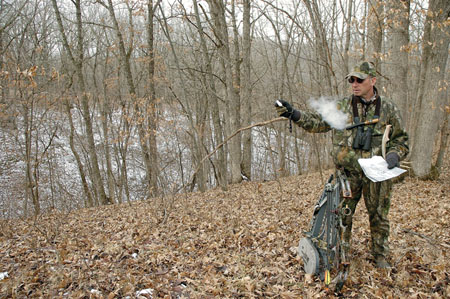 Becoming a good rough-country bowhunter revolves around understanding how the terrain affects the movements of the wind and how it affects the movements of deer. Both are predictable. After many years of hunting the broken country, my education is still in process, but I have concluded one thing: ridges and benches hold the most promise and are the easiest to hunt. If you learn to hunt them well, you’ll take more than your share of rough land bucks.
Becoming a good rough-country bowhunter revolves around understanding how the terrain affects the movements of the wind and how it affects the movements of deer. Both are predictable. After many years of hunting the broken country, my education is still in process, but I have concluded one thing: ridges and benches hold the most promise and are the easiest to hunt. If you learn to hunt them well, you’ll take more than your share of rough land bucks.
Overcoming the Wind to Your Stand
It doesn’t matter what the deer are doing if they smell you before they get into bow range, so the first priority anytime you hunt ridge and bluff country is to find spots where your scent will blow in a predictable direction. You may as well realize right up front that the wind is not your friend. At best it is a patient enemy. Anytime you place your stand in an area that is protected from the direct blast of the wind, you can expect swirling and trouble.
Hunt either near ridgetops where the flow is unbroken and consistent, or sparingly in wide draws where swirling is reduced. If you take nothing else from this article, remember that getting the wind right is the greatest challenge of bowhunting broken country.
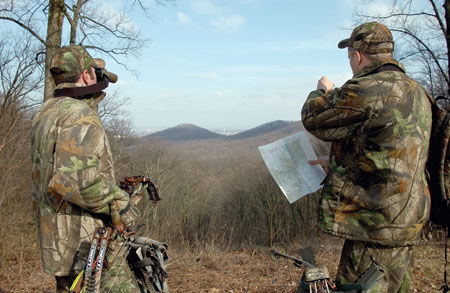 How Deer Use Ridges
How Deer Use Ridges
Ridges offer excellent visibility and maximum security to bedded deer. Most ridges extend out over a bottom area or ravine, and the point where they end is usually a heavily used bedding area. As you move farther back along the ridge, away from the bedding areas and generally toward feeding areas (acorn-dropping oak groves or cropfields), you’ll find heavy trails on top. Does and fawns use them most often, but bucks will also travel here if the hunting pressure is light enough or the rut is near its peak.
On either side of the ridge, you will find trails about 30 to 40 yards down the hill. These won’t be as heavily used and will often be marked by rubs. In order to keep a low profile, bucks are most apt to travel these sidehill trails while using the wind to monitor activity that is taking place on the ridgetop. For this reason, the trail on the downwind side of the ridgetop is a great stand site.
Ridgetop Patterns
Besides the sidehill trails, which are the easiest ridge pattern to find and hunt, here are three more patterns you should look for when hunting rugged country.
Ridge crossings:
For nearly half a mile the ridgetop was open, save for one narrow finger of timber that crossed over the top and joined the two sides. It was a natural, low-profile crossing point for deer traveling from one sidehill timber to the other. My stand was on the downwind side of the ridgetop where I could cover the two trails deer followed when moving along this wooded, ridge-crossing strip. Also within range, but slightly below me on the hill, was the heavily used side trail. I felt like I was in position to get a shot at nearly every deer that traveled the ridge.
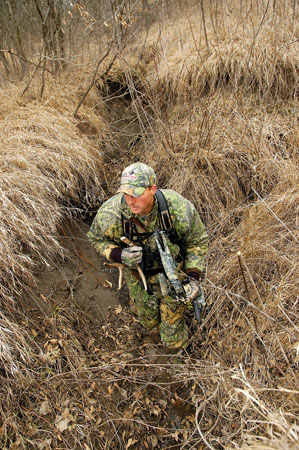 A nice 10-pointer followed the strip of cover over the ridge and right to my stand an hour before sunset. At 18 yards, he stopped to freshen a scrape and moments later, when he turned, I had my payoff for the long hours. The following year, while hunting an identical setup on a different ridge several miles away, I took a dandy 8-pointer.
A nice 10-pointer followed the strip of cover over the ridge and right to my stand an hour before sunset. At 18 yards, he stopped to freshen a scrape and moments later, when he turned, I had my payoff for the long hours. The following year, while hunting an identical setup on a different ridge several miles away, I took a dandy 8-pointer.
Those two deer were enough to prove, early in my bluff-hunting education, that this pattern is the best you can find when hunting ridgetops. Here’s how to set up: First, find some sort of structure that goes over the ridgetop and connects the two sidehills. Usually, this takes the form of a brushy fence line or strip of timber—the perfect travel corridor for a buck trying to keep a low profile while he searches for does on both sides of the ridge.
Without a doubt, there will be a deer trail on each side of the structure. Make sure you can cover both from your stand. Now move down the sidehill on what would normally be the prevailing downwind side. You should come across the edge or sidehill trail. All that’s left is to find a tree that allows you to keep all three of these trails within bow range. You can say this easier than you can do it, but with a little patience you will work things out.
If you can’t find a fenceline or an unbroken band of cover that connects both sides of an open ridgetop, look for fingers of timber extending toward each other from opposite sides of the open ridgetop. Even though they don’t offer complete concealment for a traveling buck, the fingers do hide him for a portion of the crossing. He’ll take advantage of that, and so should you.
The best way to access this ridge stand is to come in from below, straight up the hill into the wind, or you will pollute too much country with your scent.
Ditches:
Ditch crossings are easy to find and easy to hunt, and most importantly, they produce good action. Anytime there’s a slope there’s bound to be run-off and erosion. Some of the erosion ditches that cut down the sides of a ridge are so deep and/or steep that deer don’t cross them unless pushed. This sets up the perfect scenario for funneling.
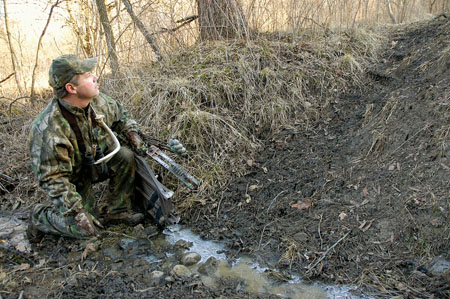 Deer are much more likely to go around such a ditch than to cross it, meaning the upper end and the lower end are natural hotspots that nearly every deer using the sidehill will have to pass through. I’ve already pointed out how tough it is to hunt down in the bottom of a draw, so this basically eliminates the lower end of the ditch, leaving only one choice—the top. But it’s a very good choice. Ditches usually form between two side ridges where does often bed. During the rut, bucks will trade between these places making the ditch funnel a natural hotspot.
Deer are much more likely to go around such a ditch than to cross it, meaning the upper end and the lower end are natural hotspots that nearly every deer using the sidehill will have to pass through. I’ve already pointed out how tough it is to hunt down in the bottom of a draw, so this basically eliminates the lower end of the ditch, leaving only one choice—the top. But it’s a very good choice. Ditches usually form between two side ridges where does often bed. During the rut, bucks will trade between these places making the ditch funnel a natural hotspot.
When scouting a steep sidehill, look for deep ditches and follow them uphill until you come to the first well-used crossing. Often this will take you very close to the top of the ridge, or near the field edge (if the ridgetop is wide enough to cultivate). This is where your stand goes. Whenever possible, set up where you can get a shot to the field edge, or the ridgetop, as well as the ditch crossing.
You’re going to be tempted to move your stand a little ways above the ditch crossing so you can better shoot to the field edge or ridgetop. I once did this as a matter of routine, thinking my scent would blow over the heads of nearby deer. While this may work fine when the wind is steady, any gusting will cause swirling and deer downwind of your stand (even a short distance) will smell you. Make it a priority to keep your stand downwind of all likely deer travel routes to play it safe.
Access is a no-brainer. Hunt the ditch stand only when the wind is blowing toward it from the top of the ridge. That wind will carry your scent down over the ditch and over the valley below—where deer are not likely to pass. When approaching or exiting this stand, walk right up the bottom of the ditch. This eliminates any chance that deer will see you, and reduces the risk that they’ll hear you or smell you.
Being able to get in and out clean is one of the most attractive parts of this ridge pattern. If the ditch is choked with deadfalls, take some time during the off-season to use a chainsaw and cut a path through it. When fall comes you will be very glad you did.
Saddles:
Hunting authors have written much about the effectiveness of hunting saddles in ridgelines, but it bears repeating. Deer are opportunists and will take the path of least resistance anytime it doesn’t compromise their security. Saddles offer traveling bucks the perfect place to cross a ridgetop. They reduce the work involved and keep a buck from skylining himself in the process. Setting up on a saddle is slightly less cut and dried than the other two ridgetop patterns I’ve covered. You’ll need to take each case as it comes and you may have to observe the action from your first stand for a few trips before moving to the very best tree. There is no shame in getting it wrong the first time. We all do it. That is part of bowhunting.
In general, set up on the downwind lip of the ridge, to one side or the other of the saddle. The wind direction required to hunt the spot will depend upon where the deer are coming from as they converge on the saddle. Likely, they will be following the sidehill trail giving you an opportunity to set up just below that trail but in line with the saddle.
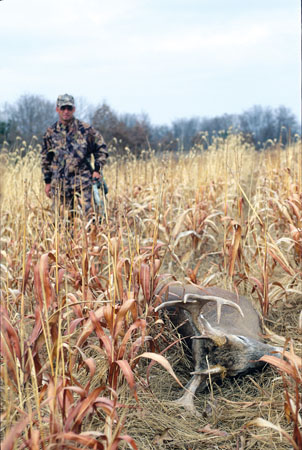 Hunting Benches
Hunting Benches
Benches are usually the hottest places to hang a stand in rough country if the wind will cooperate—which, unfortunately, it rarely does. Every bench I’ve ever scouted was torn up with trails and rut sign. It is obvious that these bedding and travel areas serve as major contact points for bucks looking for does, and much of an area’s entire rutting activity takes place here.
Benches aren’t easy to find. In fact, the majority of those that I hunt are actually old, overgrown logging roads. Natural benches tend to be wider and, for the most part, show more signs of heavy use. But regardless of how they were made, swirling winds make all benches tough to hunt.
You can effectively hunt only those benches located on the sidehill facing the wind. Benches down in narrow draws won’t work because the wind will swirl too much. The valley has to be wide to give the wind a straight shot at the sidehill so it won’t swirl. You can also get away with hunting a bench in a narrow valley on those perfectly still mornings that seem to come along only once a season. With no wind, thermals will carry your scent either straight up (when the sun hits the slope) or straight down (when it is in shadow). Either direction will keep your scent away from deer traveling the bench.
You can best access benches from above. I like to slink down a ditch to the chosen spot whenever possible to stay out of sight. On those rare occasions when the conditions allow you to hunt one of these hotspots, plan to stay on stand all day long. You may get to hunt the stand only once or twice a year, but if you don’t mess things up by hunting it at the wrong times, once or twice may be enough.
Some of the biggest bucks in North America live in rugged country because these are some of the most difficult places to hunt effectively. If you’ll focus on ridges and benches and forget the sign you find in the bottoms of draws, you’ll shoot more and bigger bucks this season.






